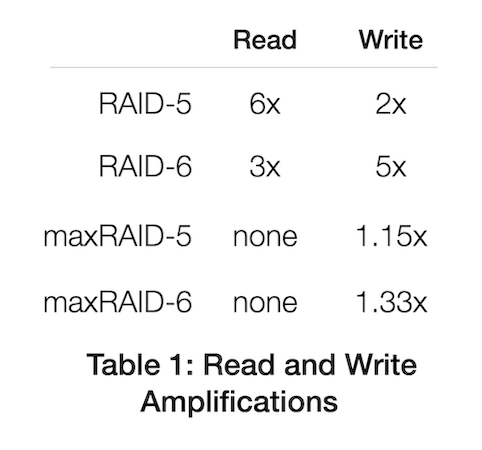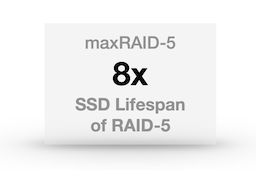How maxRAID Optimizes All-Flash Arrays
maxRAID is a host-based Flash Translation Layer (FTL) that optimizes All-Flash Arrays, delivering outstanding performance and reliability. But how does it achieve such impressive results? The answer lies in intelligent design, advanced engineering, and mathematically driven innovation that distinguishes maxRAID from traditional solutions.
maxRAID’s Advanced Approach to WAF and Compression
At its core, maxRAID is a sophisticated block translation layer specifically designed to excel at managing garbage collection for random writes, a critical factor in reducing the Write Amplification Factor (WAF). WAF is an essential metric for the longevity of SSDs, as excessive write amplification can lead to premature wear and failure. As early as 2015, we employed a Monte Carlo simulator to model garbage collection and measure WAF under various conditions. The results of these simulations were validated by real-world maxRAID deployments, demonstrating that maxRAID consistently operates within 0.5% of the theoretical best-case WAF. This precise performance ensures optimal efficiency, helping organizations maximize the lifespan of their SSDs while minimizing write overhead.
Compression is another critical aspect of maxRAID’s design. By compressing data blocks, maxRAID significantly reduces write sizes, decreasing WAF and enhancing storage efficiency. This often allows WAF to drop below 1:1, an impressive achievement that few solutions can attain. Compression not only lessens write workloads but also creates additional free space, further lowering WAF. This dual benefit of reduced data size and increased free space directly translates into improved reliability, enhanced performance, and cost savings. As compression ratios improve, maxRAID dynamically adjusts to optimize storage capacity while maintaining peak performance, making it an ideal solution for evolving and unpredictable workloads.
Innovative Management of Empty Blocks
maxRAID transcends traditional SSDs by intelligently handling ‘empty’ blocks. While most SSDs offer basic trim/discard commands, maxRAID enhances this capability by automatically executing trim/discard operations whenever a block is written with all zeroes or ones. This proactive strategy ensures that maxRAID integrates seamlessly across various environments, including SANs and virtualized infrastructures, without the need for explicit support from clients or hypervisors. This universal compatibility removes potential integration hurdles and allows organizations to adopt maxRAID without revamping their existing storage architectures.
Optimized RAID Integration for Superior Performance
One of the standout features of maxRAID is its innovative positioning of the FTL above the RAID layer, rather than within the SSD. When the FTL is placed below RAID, RAID operates as an ‘IO amplifier,’ effectively doubling or tripling the number of writes for RAID-10, RAID-5, or RAID-6 configurations. This also leads to additional reads for each write operation, further compounding the IO amplification issue. By relocating the FTL above the RAID layer, maxRAID ensures that RAID receives perfectly aligned, linear writes, significantly reducing IO amplification and enhancing overall system performance.
As shown in Table 1, this placement drastically reduces IO amplification across all RAID configurations, showcasing the efficiency gains achievable with maxRAID.

Maximizing Media Lifespan and Efficiency with maxRAID
These benefits multiply rather than add up. For instance, in scenarios involving 50% compressible data compared to RAID-10 on a fully utilized volume, the advantages of maxRAID are striking. Standard RAID-5 configurations typically have a WAF six times worse than RAID-10, calculated as 3:1 for 1 DWPD, which is further doubled due to mirroring requirements. In contrast, maxRAID-5, with 50% compressible data, achieves a WAF that is 0.75 times better than RAID-10. This is calculated as 0.5:1, multiplied by 1.3 for maxRAID’s WAF at 50% free space, and adjusted by 1.15 to account for RAID-5’s IO overhead.

Table 2: maxRAID media Lifespan Improvements
Future-Proofing Storage with maxRAID
maxRAID’s advantages extend far beyond wear reduction. By facilitating the use of parity RAID instead of mirroring, maxRAID significantly enhances storage capacity while ensuring data protection. Furthermore, its compression capabilities enable organizations to exchange a portion of wear endurance for increased usable space, providing a tailored solution to address specific application needs.
This intelligent design applies to all types of SSD media, including QLC, TLC, MLC, and even SLC. For instance, QLC media provides an 8x improvement over RAID-5, potentially meeting the write requirements of applications that once relied on more expensive TLC. Similarly, TLC can now act as a viable alternative where only SLC was previously considered sufficient, thereby reducing costs and enhancing storage flexibility. These optimizations lead to significant savings and increased adaptability, making maxRAID a strategic choice for businesses prioritizing efficiency.
Conclusion: maxRAID’s Scalable and Reliable Storage Solution
These advantages are most apparent in workloads that are not solely read-heavy (featuring at least 0.3 writes per day) or exhibit some level of compressibility, especially in scenarios where writing is involved. With its advanced architecture and proven reliability, maxRAID empowers organizations to future-proof their storage systems, ensuring scalability, efficiency, and long-term cost-effectiveness.

Download Our White Paper
Please provide your email address to receive the link to download the white paper. Your information will help us keep you updated with the latest insights and innovations.

